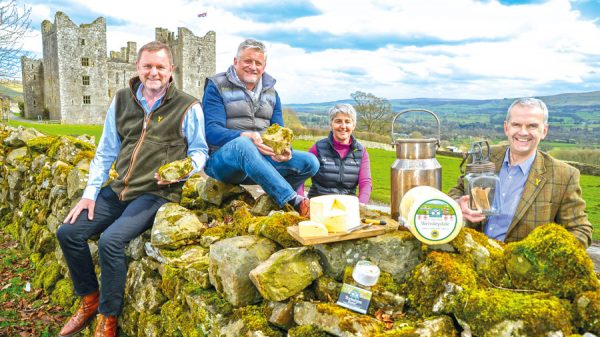Mary Watson resides in a care home only a short distance from the scene of the Barnbow disaster of December 1916, and Mary was born in the very same month that the tragedy occurred. This link of one person’s lifetime somehow brings that incident into focus, and less remote.
With thanks to the many courageous men and women of WW1, Mary and many others survived. The strength of herself and others was then tested further again through the second World War.
We offer our congratulations to Mary who celebrated her 100th birthday together with her five children. Mary also received special birthday wishes from her 11 grandchildren and 14 great-grandchildren who due to her frailty and the limited space couldn’t join her on her special day. She was also delighted to receive a card from the Queen.
In marked contrast to Mary’s long life, her elder sister died aged 17 when Mary was only 13. TB can today readily be treated. In 1930 it was still a scourge. It may be that this affected Mary, who became something of a “wild child”, who would even escape through her bedroom window to go dancing.
Brought up in a strict and staid, although loving home she was denied her wish to become a dressmaker. Being a shop girl at Woolworth’s was viewed by her parents as a much more genteel occupation.
An early marriage (1935) and family followed. They never realised until much later how much Mary denied herself in order to nourish them during the wartime rationing. Make do and Mend was the order of the day, and with the aid of a constantly whirring old Singer treadle sewing machine she became an expert seamstress, keeping all decently clothed. After the family’s postwar move to Leeds she found employment in the clothing industry, then a major employer, which furthered her abilities, to the extent that later she made the wedding dresses and bridesmaids’ outfits for her three daughters. Knitting was also something of an obligatory skill in the days of austerity. In the 1950s she would produce one jumper or cardigan in the course of a holiday journey to Devon, and another on the way back. She was ever industrious and seldom, if ever, idle.
In the 1970’s she returned to her early love of dancing, winning competitions, wearing her own dress creations. Widowed at the age of 64 she carried on dancing until almost 90, outliving three more dancing partners.
Mary was always a rather slight figure, doubted by her mother-in-law to have the energy and stamina to cope with a family, those being the days of peggy tubs, poshers, rubbing boards, mangles and carpet beaters. Perhaps all this exercise gave her the fitness to survive two serious illnesses. Even now, after a major stroke at age 98, she is confounding the medics who gave her three weeks to live.Mary Watson resides in a care home only a short distance from the scene of the Barnbow disaster of December 1916, and Mary was born in the very same month that the tragedy occurred. This link of one person’s lifetime somehow brings that incident into focus, and less remote.
With thanks to the many courageous men and women of WW1, Mary and many others survived. The strength of herself and others was then tested further again through the second World War.
We offer our congratulations to Mary who celebrated her 100th birthday together with her five children. Mary also received special birthday wishes from her 11 grandchildren and 14 great-grandchildren who due to her frailty and the limited space couldn’t join her on her special day. She was also delighted to receive a card from the Queen.
In marked contrast to Mary’s long life, her elder sister died aged 17 when Mary was only 13. TB can today readily be treated. In 1930 it was still a scourge. It may be that this affected Mary, who became something of a “wild child”, who would even escape through her bedroom window to go dancing.
Brought up in a strict and staid, although loving home she was denied her wish to become a dressmaker. Being a shop girl at Woolworth’s was viewed by her parents as a much more genteel occupation.
An early marriage (1935) and family followed. They never realised until much later how much Mary denied herself in order to nourish them during the wartime rationing. Make do and Mend was the order of the day, and with the aid of a constantly whirring old Singer treadle sewing machine she became an expert seamstress, keeping all decently clothed. After the family’s postwar move to Leeds she found employment in the clothing industry, then a major employer, which furthered her abilities, to the extent that later she made the wedding dresses and bridesmaids’ outfits for her three daughters. Knitting was also something of an obligatory skill in the days of austerity. In the 1950s she would produce one jumper or cardigan in the course of a holiday journey to Devon, and another on the way back. She was ever industrious and seldom, if ever, idle.
In the 1970’s she returned to her early love of dancing, winning competitions, wearing her own dress creations. Widowed at the age of 64 she carried on dancing until almost 90, outliving three more dancing partners.
Mary was always a rather slight figure, doubted by her mother-in-law to have the energy and stamina to cope with a family, those being the days of peggy tubs, poshers, rubbing boards, mangles and carpet beaters. Perhaps all this exercise gave her the fitness to survive two serious illnesses. Even now, after a major stroke at age 98, she is confounding the medics who gave her three weeks to live.Mary Watson resides in a care home only a short distance from the scene of the Barnbow disaster of December 1916, and Mary was born in the very same month that the tragedy occurred. This link of one person’s lifetime somehow brings that incident into focus, and less remote.
With thanks to the many courageous men and women of WW1, Mary and many others survived. The strength of herself and others was then tested further again through the second World War.
We offer our congratulations to Mary who celebrated her 100th birthday together with her five children. Mary also received special birthday wishes from her 11 grandchildren and 14 great-grandchildren who due to her frailty and the limited space couldn’t join her on her special day. She was also delighted to receive a card from the Queen.
In marked contrast to Mary’s long life, her elder sister died aged 17 when Mary was only 13. TB can today readily be treated. In 1930 it was still a scourge. It may be that this affected Mary, who became something of a “wild child”, who would even escape through her bedroom window to go dancing.
Brought up in a strict and staid, although loving home she was denied her wish to become a dressmaker. Being a shop girl at Woolworth’s was viewed by her parents as a much more genteel occupation.
An early marriage (1935) and family followed. They never realised until much later how much Mary denied herself in order to nourish them during the wartime rationing. Make do and Mend was the order of the day, and with the aid of a constantly whirring old Singer treadle sewing machine she became an expert seamstress, keeping all decently clothed. After the family’s postwar move to Leeds she found employment in the clothing industry, then a major employer, which furthered her abilities, to the extent that later she made the wedding dresses and bridesmaids’ outfits for her three daughters. Knitting was also something of an obligatory skill in the days of austerity. In the 1950s she would produce one jumper or cardigan in the course of a holiday journey to Devon, and another on the way back. She was ever industrious and seldom, if ever, idle.
In the 1970’s she returned to her early love of dancing, winning competitions, wearing her own dress creations. Widowed at the age of 64 she carried on dancing until almost 90, outliving three more dancing partners.
Mary was always a rather slight figure, doubted by her mother-in-law to have the energy and stamina to cope with a family, those being the days of peggy tubs, poshers, rubbing boards, mangles and carpet beaters. Perhaps all this exercise gave her the fitness to survive two serious illnesses. Even now, after a major stroke at age 98, she is confounding the medics who gave her three weeks to live.







